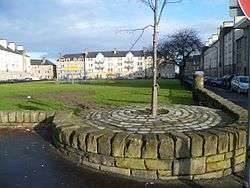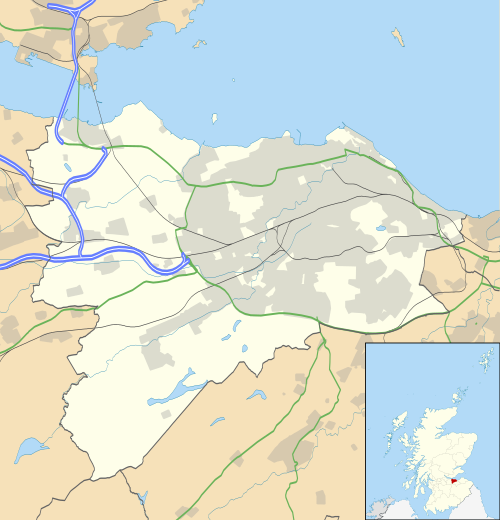Piershill Barracks
Piershill Barracks was a military installation in Piershill in Edinburgh.
| Piershill Barracks | |
|---|---|
| Piershill, Edinburgh, Scotland | |
 Remains of a wall tower of Piershill Barracks | |
 Piershill Barracks | |
| Coordinates | 55.956°N 3.146°W |
| Site history | |
| Built | 1793 |
| Built for | War Office |
| In use | 1793-1934 |
History
The barracks were built as part of the British response to the threat of the French Revolution and were completed in 1793.[1] Built along three sides of a quadrangle,[2] they were occupied by various cavalry regiments who would exercise their horses along Portobello Beach.[3]
Regiments there were the Dragoon Guards, Light Dragoons, 9th Lancers, Inniskilling Dragoons, 7th Hussars and the Royal Scots Greys.[4]
A General Court Martial was convened at the barracks on 25 September 1820 by order of Major-General Sir Thomas Bradford, Commander in Chief, Scotland, to try all such prisoners brought before it, with Colonel Sir William Williams K.C.B. (later Major-General William Williams (1776-1832)) as presiding officer.[5]
They became the home of the Royal Scots Greys in the late 19th century[6] but were condemned as insanitary and unfit for occupation by cavalry regiments in the early 20th century; this gave rise to concerns that the Royal Scots Greys would be disbanded leaving Scotland without a cavalry regiment.[7] In practice the Royal Scots Greys moved to Redford Barracks and Piershill Barracks continued to be used on a much smaller scale by the Royal Horse Artillery.[7]
The barracks were vacated in 1934 and demolished in 1935, shortly before the start of the Second World War.[1] The site is now occupied by the Piershill Square tenement blocks which were constructed in 1936 using stone from the old barracks.[8] The blocks were created as Council housing by the City Architect, Ebenezer James MacRae.[9]
References
- "Piershill Barracks". Canmore. Retrieved 9 October 2016.
- Coghill, Hamish (2008). Lost Edinburgh: Edinburgh’s Lost Architectural Heritage. Birlinn. ISBN 978-1841587479.
- "Portobello Beach". Portobello heritage trust. Retrieved 9 October 2016.
- "Full text of "Scottish Record Society. [Publications]"". Archive.org. 2016-10-23. Retrieved 2019-01-05.
- The Caledonian Mercury, 21 September 1820
- "The defence of Edinburgh during the great war of 1897". Victorian military society. Archived from the original on 1 May 2016. Retrieved 9 October 2016.
- "Piershill Barracks, Edinburgh". Hansard. 3 December 1906. Retrieved 9 October 2016.
- Historic Environment Scotland. "2-12 (even numbers) Restalrig Road South, 1-21 (odd numbers) Portobello Road... (Category C) (LB49047)". Retrieved 21 March 2019.
- "Ebenezer MacRae: The man who shaped modern Edinburgh". The Scotsman. 21 February 2017. Retrieved 5 January 2018.